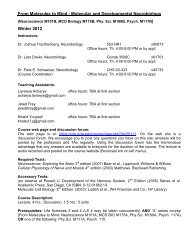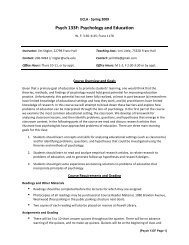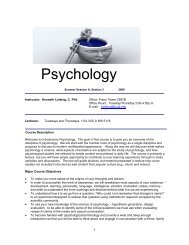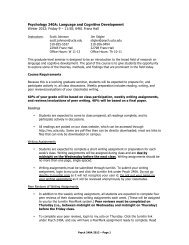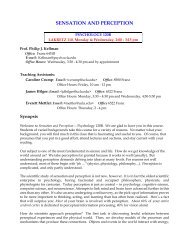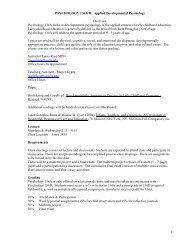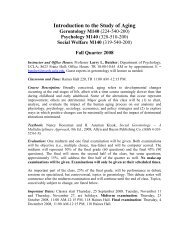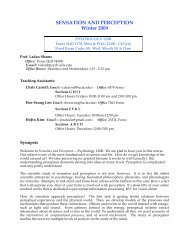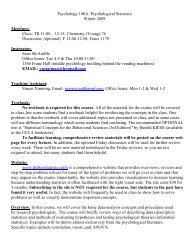Course Overview and Goals: - Courses in Psychology - UCLA
Course Overview and Goals: - Courses in Psychology - UCLA
Course Overview and Goals: - Courses in Psychology - UCLA
You also want an ePaper? Increase the reach of your titles
YUMPU automatically turns print PDFs into web optimized ePapers that Google loves.
<strong>UCLA</strong> PSYCHOLOGY 100A: PSYCHOLOGICAL STATISTICS W<strong>in</strong>ter 2009Lectures: Tuesdays <strong>and</strong> Thursdays 2:00 – 3:15pm (1178 FRANZ)Discussion: Fridays 1:00 – 1:50pm (1178 FRANZ)Instructor: Prof. Rajesh R N<strong>and</strong>yOffice: Franz 6437BPhone: 310-206-7257Email: rrn<strong>and</strong>y@gmail.com, n<strong>and</strong>y@psych.ucla.eduOffice Hours: 3:30-5:30pm Tuesdays <strong>and</strong> by appo<strong>in</strong>tmentTeach<strong>in</strong>g Assistant: Yueyan WangOffice: Franz 1340BEmail: yueyanw@gmail.comOffice Hours: Thursdays 9:00am-11:00amClass Web Site: http://courses.psych.ucla.edu/course.php?srs=328304200&term=09WPlease refer all adm<strong>in</strong>istrative questions <strong>and</strong> enrollment requests to the <strong>Psychology</strong> Undergraduate Advis<strong>in</strong>gOffice (1531 Franz Hall).<strong>Course</strong> <strong>Overview</strong> <strong>and</strong> <strong>Goals</strong>:This course <strong>in</strong>troduces the statistics commonly used <strong>in</strong> psychological research. By course end, you should beable to:(1) Underst<strong>and</strong> the basic concepts underly<strong>in</strong>g descriptive <strong>and</strong> <strong>in</strong>ferential statistics;(2) Perform basic statistical analyses;(3) Apply these concepts <strong>and</strong> procedures to the design, analysis, <strong>and</strong> <strong>in</strong>terpretation of psychologicalresearch data.<strong>Course</strong> Structure:The material divides naturally <strong>in</strong>to six sections: (1) Describ<strong>in</strong>g Data, (2) Statistical Inference <strong>and</strong> Estimation,(3) Hypothesis Test<strong>in</strong>g, (4) Correlation <strong>and</strong> L<strong>in</strong>ear Regression, (5) Chi-square <strong>and</strong> Nonparametric tests, <strong>and</strong>(6) Analysis of Variance (ANOVA).The material builds cumulatively. For example, you must underst<strong>and</strong> distributions to underst<strong>and</strong>variability <strong>and</strong> you must underst<strong>and</strong> variability to underst<strong>and</strong> ANOVA.Topics to be covered:(1) Describ<strong>in</strong>g Data (2 Lectures)Research Design <strong>and</strong> Data Analysis, Distributions, Central Tendency, Variability(2) Statistical Inference <strong>and</strong> Estimation (3 Lectures)Normal Distributions, Probability, St<strong>and</strong>ard Scores, Distribution of the Mean, Parameter Estimation,Confidence Intervals(3) Hypothesis Test<strong>in</strong>g (4 Lectures)z Test <strong>and</strong> One-Sample t Test, Power <strong>and</strong> Effect Size, Two Independent Means, Two DependantMeans(4) Correlation <strong>and</strong> L<strong>in</strong>ear Regression (2 Lectures)
L<strong>in</strong>ear Regression <strong>and</strong> Error <strong>in</strong> Prediction, Predict<strong>in</strong>g X from Y, Us<strong>in</strong>g a L<strong>in</strong>ear Regression L<strong>in</strong>e,Multiple Regression, Correlation(5) Chi-square <strong>and</strong> Nonparametric Tests (1 Lecture)(6) Analysis of Variance (ANOVA) (5-6 Lectures)One-Factor Between-Subjects, Two-Factor Between-Subjects, One-Factor With<strong>in</strong>-SubjectsCALENDAR FOR PSYCH 100A – (subject to slight variations when needed)Tue Thu Fri1/6 Describ<strong>in</strong>g Data 1—Introduction <strong>and</strong> Basic Concepts,Distributions. (Kiess Ch 1-3)1/13 Statistical Inference 1 —Normal Distributions, Probability,Std Scores. (Ch 6)1/20 Hypothesis Test<strong>in</strong>g 1 — zTest <strong>and</strong> One-Sample t Test. (Ch8).1/27 Hypothesis Test<strong>in</strong>g 3 — Two1/8 Describ<strong>in</strong>g Data 2—Distributions, Central Tendency<strong>and</strong> Variability. (Ch 3-5)1/15 Statistical Inference 2 —Distribution of the Mean. (Ch 7)1/22 Hypothesis Test<strong>in</strong>g 2 —Power <strong>and</strong> Effect Size. (Ch 8)1/29 Hypothesis Test<strong>in</strong>g 4 — TwoIndependent Means. (Ch 9) Dependent Means. (Ch 9)2/3 MIDTERM 1 EXAM 20% of 2/5 L<strong>in</strong>ear Regression 1 —total grade. Br<strong>in</strong>g your student Correlation, L<strong>in</strong>ear Regression.ID <strong>and</strong> calculator.(Ch 13 <strong>and</strong> 14)2/10 L<strong>in</strong>ear Regression 2 (Ch 14) 2/12 Chi-square tests <strong>and</strong>nonparametric tests (Ch 15)2/17 Analysis of Variance 2/19 ANOVA, One & Two-Factor(ANOVA), One-Factor Between- Between-Subjects (Ch 10 & 11)Subjects 1. (Ch 10)2/24 MIDTERM 2 EXAM 20%of total grade. Br<strong>in</strong>g your studentID <strong>and</strong> calculator.2/26 Discussion class forConceptual exam.3/3 ANOVA, Two-FactorBetween-Subjects 2. (Ch 11)3/10 ANOVA, One-Factor With<strong>in</strong>-Subjects 2 (Ch 12)FINAL EXAM. Tuesday, Mar 17, 2009, 11:30am-2:30pm50% of total grade. Br<strong>in</strong>g your student ID <strong>and</strong> calculator<strong>Course</strong> Requirements:Discussion ClassDiscussion ClassDiscussion ClassDiscussion ClassDiscussion ClassDiscussion ClassDiscussion ClassDiscussion Class3/5 ANOVA, One-Factor With<strong>in</strong>- Discussion ClassSubjects 1. (Ch 12)3/12 Review Discussion ClassStudy Plan: I will spend at least 12 hours a week on this class. I will pace <strong>and</strong> grade accord<strong>in</strong>g to myexpectations for an advanced <strong>UCLA</strong> undergraduate spend<strong>in</strong>g similar time. The material <strong>in</strong> this course iscumulative. I urge you to be diligent from the beg<strong>in</strong>n<strong>in</strong>g of the quarter.Textbook: Kiess, H. O. (2002). Statistical concepts for the behavioral statistics, third edition.
Allyn <strong>and</strong> Bacon. Sections <strong>in</strong> Kiess with “Computational Formula” <strong>in</strong> the head<strong>in</strong>g can be skippedCalculator: Only 5 function calculators (hav<strong>in</strong>g only plus, m<strong>in</strong>us, multiplication, division, square rootfunctions) will be allowed <strong>in</strong> exams. DON’T br<strong>in</strong>g a programmable calculator to exams. If buy yourcalculator from the <strong>UCLA</strong> student store, the Aurora HC108X, the Aurora. HC502A, the Sharp EL-244MB<strong>and</strong> the Sentry CA270 are all acceptable. If you have a question about whether your calculator is acceptable,please show it to the professor or TA dur<strong>in</strong>g their office hours.Read<strong>in</strong>g: Each section will have learn<strong>in</strong>g goals <strong>and</strong> assigned read<strong>in</strong>g. These materials will be posted on theclass web site. I will prepare lectures assum<strong>in</strong>g that you have read the learn<strong>in</strong>g goals <strong>and</strong> the assignedread<strong>in</strong>g.Formulas: Statistics <strong>in</strong>volves many formulas <strong>and</strong> derivations of formulas. Do your best to read thesederivations because they will help you underst<strong>and</strong> the concepts <strong>and</strong> help you remember the formulas. Theformulas you will be required to remember for exams will be listed on the website. You can skip all sections<strong>in</strong> Kiess with the words “Computational Formula” <strong>in</strong> the head<strong>in</strong>g.Homework: Homework will be assigned weekly. The homework will not be collected. Answer keys will beprovided for self-grad<strong>in</strong>g. Homework questions will be similar to exam questions.Pop Quiz: There will be six r<strong>and</strong>om pop quizzes (multiple choice) dur<strong>in</strong>g lecture days either at thebeg<strong>in</strong>n<strong>in</strong>g or at the end of the lecture. Only the best four will be counted towards your f<strong>in</strong>al score. Each popquiz will cover materials taught <strong>in</strong> the previous two lectures.Evaluation:Scor<strong>in</strong>g: Pop Quiz = 10%, Midterm 1 = 20%, Midterm 2 = 20%, F<strong>in</strong>al = 50%Br<strong>in</strong>g your Student ID to all exams!Grades: Your f<strong>in</strong>al course grade will be based on your total score (rounded to the nearest <strong>in</strong>teger) strictlyus<strong>in</strong>g the follow<strong>in</strong>g scheme.95-100 90-94 80-89 70-79 65-69 60-64 55-59 50-54 40-49 0-39A+ A A- B+ B B- C+ C C- DGett<strong>in</strong>g Help:Both the professor <strong>and</strong> the teach<strong>in</strong>g assistant want you to succeed at learn<strong>in</strong>g statistics. If you have questions,please ask them <strong>in</strong> class, discussion, come to office hours or by email.Study groups: One of the best ways to learn this material is to form study groups. Teach<strong>in</strong>g is a great way tolearn a subject, <strong>and</strong> study groups are students teach<strong>in</strong>g each other. You will f<strong>in</strong>d that some homeworkquestions will be best h<strong>and</strong>led if you can discuss them with your peers. If you have trouble form<strong>in</strong>g orf<strong>in</strong>d<strong>in</strong>g a group, come to the discussion section to f<strong>in</strong>d others look<strong>in</strong>g for a study group.Office Hours: The best way to use office hours is to come prepared. First, review the learn<strong>in</strong>g goals, then
eread the chapter, review your lecture notes, <strong>and</strong> spend time work<strong>in</strong>g on the homework with a study group.Then come to office hours with specific questions on these materials. Br<strong>in</strong>g your class notes <strong>and</strong> yourhomework to office hours.Policies:(1) This course is impacted, so you will only be permitted to add/drop dur<strong>in</strong>g the first two weeks. Dur<strong>in</strong>gthese two weeks, you may add/drop this course by us<strong>in</strong>g URSA. The professor cannot sign PTE forms at anytime dur<strong>in</strong>g the quarter. If you have any enrollment concerns, please visit the <strong>Psychology</strong> UndergraduateAdvis<strong>in</strong>g Office (1531 Franz Hall) to meet with an academic counselor.(2) There will be no scheduled makeup exams. Under rare <strong>and</strong> extreme circumstances (medical illness withcomplete medical documentation or death of an immediate family member with documentation), you will beexcused from a midterm <strong>and</strong> given your percentile score from the f<strong>in</strong>al <strong>in</strong>stead. If you already know youcan’t make a midterm, you need to take the other section of this course. If you miss the f<strong>in</strong>al, you willautomatically receive a score of zero for f<strong>in</strong>al. No <strong>in</strong>completes can be given <strong>in</strong> <strong>Psychology</strong> 100A.(3) Accord<strong>in</strong>g to the Provost’s policy, there will be NO changes to any exam or f<strong>in</strong>al grades except to correctclerical error.



